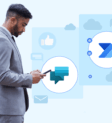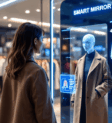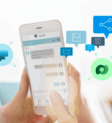7 Ways Marketing Bots Can Drive Lead Generation

Research by Outgrow shows that 3 in 5 millennials have used chatbots at least once in their lives. Additionally, Gartner states that by 2023, 30% of customer service organizations will deliver proactive customer services using AI-enabled process orchestration and continuous intelligence. Moreover, by 2025, customer service organizations will elevate operational efficiency by 25% by embedding AI in their multichannel customer engagement platforms.
The past year has transformed customer dynamics and redefined what customers consider “easy” and “seamless” customer experience (CX). With customers worldwide shifting to online brands, AI has emerged as the top spending priority for businesses to meet the need for instant and personalized customer interactions.
Indeed, chatbots have helped brands meet customers at their preferred touchpoints, build lasting relationships, and support what most organizations call the “new-age” customer experience.
Organizations can use conversational AI chatbots to build a foolproof CX strategy, including generating qualified leads for the brand. In fact, 36% of companies are already using AI chatbots to generate more leads.
Marketing bots, particularly those expressly designed for lead generation (lead bots), collect information from prospects and automatically qualify valuable leads from a myriad of incoming web traffic. This allows the sales team to focus on only those prospects that could potentially generate business for the company in the future.
Marketing bots can provide on-demand access to information, unrivaled 24X7 support, and user-friendly UX whenever a prospect lands on the brand’s website. By answering preliminary questions regarding the product and collecting prospect information, such bots can keep people longer on the landing page and help sift out leads qualified to move down the sales funnel.
This blog explores the seven ways marketing bots can drive lead generation for your company.
Let’s begin with a real-life example.


If a prospect goes onto HubSpot’s Facebook page, a Messenger chatbot automatically pops up to help the user get started. The moment the website visitor clicks on “Get Started,” an automated greeting message along with a list of probable actions, such as “Subscribe to our weekly newsletter.” or “Check out our new tools for free,” is displayed on the screen. This method of getting subscribers and leads is easier than asking leads to sign up manually. Moreover, the bot can map the Facebook Messenger leads to email, and kickstart an email campaign.
Just like HubSpot, all organizations can leverage marketing bots to get inbound leads in a streamlined and scalable manner.
So, here are the top 7 ways marketing bots are helping organizations drive lead generation –
1. Form a better understanding of the target audience
For any organization, understanding the target audience is the foundation for converting leads. When a prospect visits the website, the bot sends a welcome message like “Want to know about Product X? Just say HELLO to get started.”
A playful welcome message with a human-like touch marks the beginning of a potentially fruitful conversation with the prospect.
The bot moves on to ask a few qualifying questions to understand the prospect’s intent and recommend suitable products and services.
The bot can comprehend likes and dislikes through an initial conversation with the prospect, answer questions, and provide valuable information (instructions, tips, and helpful videos).
Moreover, AI chatbots can do away with the traditional, tedious, and often time-consuming practice of lead generation via form fill-ups. They can streamline information collection and create a frictionless and more exciting process of asking qualifying questions by providing multiple options.
Based on the response and automatic buyer persona creation, the bots can qualify leads and direct them to the right team of experts for further nurturing.
2. Segment customers for targeted nurturing
Segmentation involves profiling the audience based on factors like geography, company size, revenue, business needs, etc., to help deliver more meaningful engagement.
Organizations can design AI chatbots to segment the audience based on data collected, deliver relevant marketing messaging to nurture leads suitably, and increase the probability of conversion.
3. Automatic pre-qualification of leads at scale
Customer-facing chatbots can create exceptional conversational experiences for customers and automatically qualify potential leads at scale.
A conversational AI bot can qualify leads by asking a pre-defined set of industry-specific questions even when sales agents are busy or unavailable. Consequently, such bots can direct qualified leads to the sales team for more focused nurturing.
4. Integration of live chat widget with a marketing bot
Brand websites usually deploy a live chat widget to help streamline communication, provide real-time responses, and aid lead generation, even when the human agent is unavailable.
Such chat widgets may include onboarding (or welcome) chat widgets, support chat widgets, feedback chat widgets, or a general chat widget.
A live chat widget integrated with a lead bot can drive lead generation for brands. All the prospective lead has to do is provide details like name, contact details, and query, and the bot can collect this information so that an agent can address the concern as soon as business-as-usual resumes.
5. Schedule appointments round-the-clock with marketing bots
Often, B2B firms see a lot of incoming requests for scheduling demos and one-on-one consultations.
Conversational AI chatbots can guide qualified leads to book product demos and sales meetings. They can collect relevant information, propose slots for appointments, and send booking confirmations to the meeting participants.
With marketing bots, organizations needn’t worry about booking hassles or hiring employees to manage appointments.
6. Get qualified leads from across the world with multilingual customer-facing bots.
In today’s highly digitized business landscape, most organizations have a customer base that spans different geographies. Prospects are often more comfortable engaging with brands that speak their native tongue and understand cultural nuances.
Implementing a multilingual customer-facing bot helps companies span geographies and engage with incoming leads from various locations, improving engagement and conversion in the process.
Moreover, a multilingual bot gives customers an edge over competitors and increases the possibility of converting leads from across the globe.
7. Recapture interest with triggered messaging
Sometimes customers may not be sufficiently engaged, have difficulties navigating the brand’s website, or have questions about the product.
At other times, the customer may try to leave the website, and hence brands may wish to reel them back in.
Here, timing and personalization are crucial in re-engaging the customer. A marketing bot can send out trigger messages in the form of pop-up windows, such as “50% discount just for you” or “Sign up to learn about upcoming sales.”
When the user has already left the website, the bot may send an email that reads, “Pssst….we see you left something in your cart. Come back to avail a 20% discount.”
Benefits of Using Marketing Bots to Drive Lead Generation
- 24×7 customer service representative
- Enhance B2B customer experience
- Generate valuable leads at scale
- Reduce the cost of generating leads
- Increase ROI
How can Acuvate help?
At Acuvate, we help clients deploy AI-enabled marketing bots and drive lead generation with our enterprise bot-building platform called BotCore.
With minimalistic coding requirements and a graphical design interface, BotCore allows enterprises to build and implement customer-facing chatbots within weeks. As a Microsoft Gold Partner, we leverage the best of Microsoft’s AI, ML, and NLP technologies to build bots that deliver exceptional customer interactions.
Moreover, our bots are multilingual and can cater to a global audience with support for languages such as French, German, Italian, English, etc. Additionally, we support various platforms, including email, web, mobile app, and social media applications like WhatsApp and Facebook Messenger.
We also use Microsoft’s low-code bot-building solution, Power Virtual Agents (PVA), to help clients quickly build intelligent, conversational AI chatbots with little or no coding knowledge.
To know more about BotCore and Power Virtual Agents, please feel free to schedule a personalized consultation with our experts.
Abhishek is the AI & Automation Practice Head at Acuvate and brings with him 17+ years of strong expertise across the Microsoft stack. He has consulted with clients globally to provide solutions on technologies such as Cognitive Services, Azure, RPA, SharePoint & Office 365. He has worked with clients across multiple industry domains including Retail & FMCG, Government, BFSI, Manufacturing and Telecom.






Abhishek Shanbhag